Intel X25-V in RAID-0: Faster than X25-M G2 for $250?
by Anand Lal Shimpi on March 29, 2010 8:59 PM ESTOverall System Performance using PCMark Vantage
Next up is PCMark Vantage, another system-wide performance suite. For those of you who aren’t familiar with PCMark Vantage, it ends up being the most real-world-like hard drive test I can come up with. It runs things like application launches, file searches, web browsing, contacts searching, video playback, photo editing and other completely mundane but real-world tasks. I’ve described the benchmark in great detail before but if you’d like to read up on what it does in particular, take a look at Futuremark’s whitepaper on the benchmark; it’s not perfect, but it’s good enough to be a member of a comprehensive storage benchmark suite. Any performance impacts here would most likely be reflected in the real world.

Intel had been falling behind in the PCMark Vantage charts thanks to the SandForce and Crucial drives, but RAIDing these two X25-Vs makes up for a lot of lost time. Overall performance is basically on par with the entry level SandForce drives, but behind the C300 on a 6Gbps controller. The rest of the tests have the X25-V landing either in the middle or near the top of the charts, not bad for $250.
The memories suite includes a test involving importing pictures into Windows Photo Gallery and editing them, a fairly benign task that easily falls into the category of being very influenced by disk performance.
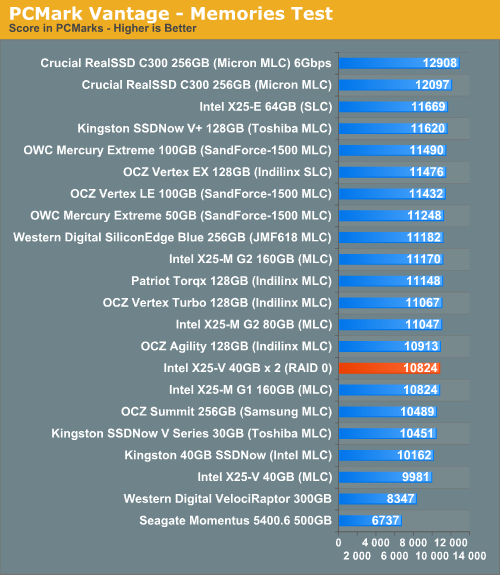
The TV and Movies tests focus on on video transcoding which is mostly CPU bound, but one of the tests involves Windows Media Center which tends to be disk bound.
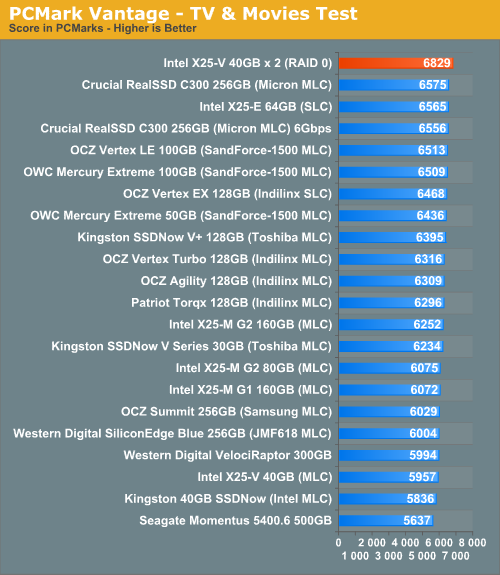
The gaming tests are very well suited to SSDs since they spend a good portion of their time focusing on reading textures and loading level data. All of the SSDs dominate here, but as you'll see later on in my gaming tests the benefits of an SSD really vary depending on the game. Take these results as a best case scenario of what can happen, not the norm.
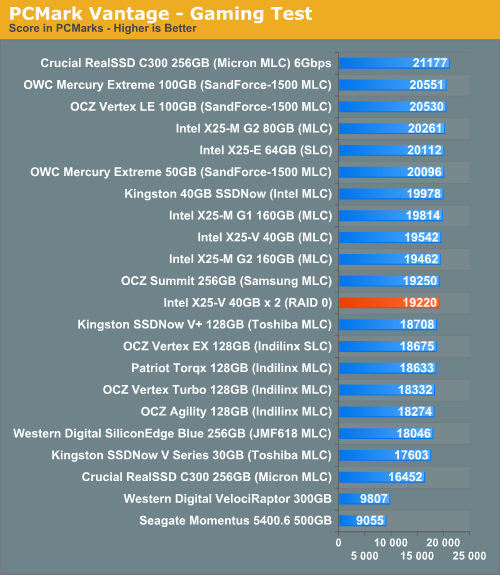
In the Music suite the main test is a multitasking scenario: the test simulates surfing the web in IE7, transcoding an audio file and adding music to Windows Media Player (the most disk intensive portion of the test).
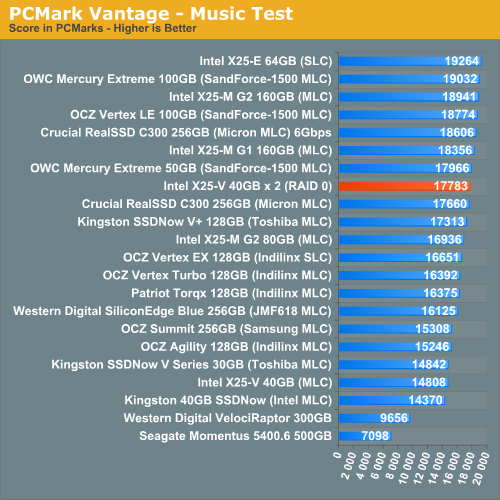
The Communications suite is made up of two tests, both involving light multitasking. The first test simulates data encryption/decryption while running message rules in Windows Mail. The second test simulates web surfing (including opening/closing tabs) in IE7, data decryption and running Windows Defender.
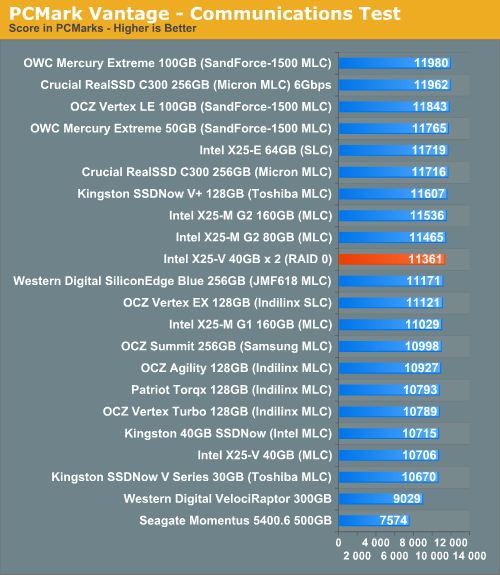
I love PCMark's Productivity test; in this test there are four tasks going on at once, searching through Windows contacts, searching through Windows Mail, browsing multiple webpages in IE7 and loading applications. This is as real world of a scenario as you get and it happens to be representative of one of the most frustrating HDD usage models - trying to do multiple things at once. There's nothing more annoying than trying to launch a simple application while you're doing other things in the background and have the load take forever.
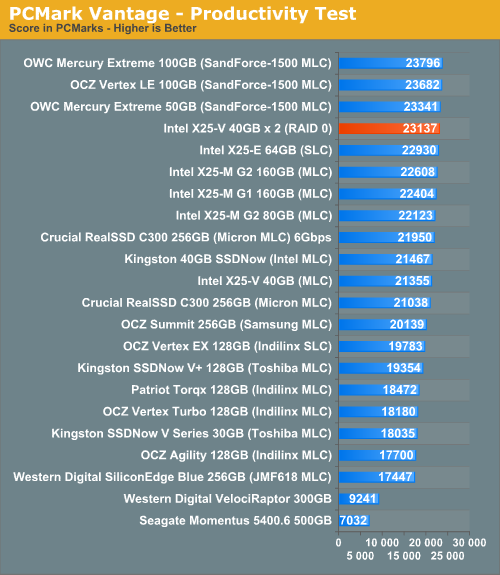
The final PCMark Vantage suite is HDD specific and this is where you'll see the biggest differences between the drives:











87 Comments
View All Comments
rhvarona - Tuesday, March 30, 2010 - link
Some Adaptec Series 2, Series 5 and Series 5Z RAID controller cards allows you to add one or more SSD drives as a cache for your array.So, for example, you can have 4x1TB SATA disks in RAID 10, and 1 32GB Intel SLC SSD as a transparent cache for frequently accessed data.
The feature is called MaxIQ. One card that has it is the Adaptec 2405 which retails for about $250 shipped.
The kit is the Adaptec MaxIQ SSD Cache Performance Kit, but it ain't cheap! Retails for about $1,200. Works great for database and web servers though.
GDM - Tuesday, March 30, 2010 - link
Hi I was under the impression that intel has new raid drivers that can pass through the TRIM command. Can you please rerun the test if that is true. Also can you test the 160gbs in raid?And although benchmarks are nice, do you really notice it during normal use?
Regards,
Makaveli - Tuesday, March 30, 2010 - link
You cannot do TRIM to an SSD Raid even with the new intel drivers.The drivers will allow you to pass trim to a single SSD+ HD RAID setup.
Roomraider - Wednesday, March 31, 2010 - link
Wrong, Wrong, Wrong!!!!!!!The new drivers does in fact pass Trim to Raid-0 in Windows 7. My 2 160 g2' striped in 0 now has trim running on the array "verified via Windows 7 Trim cmd" . According to Intel, this works with any Trim enabled SSD' No Raid 5 support yet.
jed22281 - Friday, April 2, 2010 - link
what so Anand is wrong when he speak to Intel engineers directly?I've seen several other threads where this claims has since been quashed.
WC Annihilus - Tuesday, March 30, 2010 - link
Well this is definitely a test I was looking for. I just bought 3 of the Kingston drives off Amazon cheap and was trying to decide whether to RAID them or use them separately for OS/apps and games. Would a partition of 97.5GB (so about 14GB unpartitioned) be good enough for a wear-leveling buffer?GullLars - Tuesday, March 30, 2010 - link
Yes, it should be. You can consider making it 90GiB (gibibytes, 90*2^30 bytes), if you anticipate a lot of random writes and not a lot of larger files going in and out regularly.You will likely get about 550MB/s sequential read, and enough IOPS for anything you may do (unless you start doing databases, WMvare and stuff). 120MB/s sustained and consistent write should also keep you content.
Tip: use a small stripe size, even 16KB stripe will work whitout fuzz on these controllers.
WC Annihilus - Tuesday, March 30, 2010 - link
Main reason I want to go with a 97.5GB partition is because that's the size of my current OS/apps/games partition. It's got about 21GB free, which I wanted to keep in case I wanted to install more games.In regards to stripe size, most of the posts I've seen suggest 64KB or 128KB are the best choices. What difference does this make? Why do you suggest smaller stripe sizes?
Plans are for the SSDs to be OS/apps/games, with general data going on a pair of 1.5TB hard drives. Usage is mainly gaming, browsing, and watching videos, with some programming and the occasional fiddling with DVDs and video editing
GullLars - Tuesday, March 30, 2010 - link
Then you should be fine with a 97,5GB partition.The reason smaller is better when it comes to stripe size on SSD RAIDs has to do with the nature of the storage medium combined with the mechanisms of RAID. I will explain in short here, and you can read up more for yourself you are more curious.
Intel SSDs can do 90-100% of their sequential bandwidth with 16-32KB blocks @ QD 1, and at higher queue depths they can reach it at 8KB blocks. Harddisks on the other hand reach their maximum bandwidth around 64-128KB sequential blocks, and do not benefit noticably from increasing the queue depth.
When you RAID-0, the files that are larger than the stripe size get split up in chucks equal in size to the stripe size and distributed amongs the units in the RAID. Say you have a 128KB file (or want to read a 128KB chunk of a larger file), this will get divided into 8 pieces when the stripe size is 16KB, and with 3 SSDs in the RAID this means 3 chunks for 2 of the SSDs, and 2 chukcs for the third. When you read this file, you will read 16KB blocks from all 3 SSDs at Queue Depth 2 and 3. If you check out ATTO, you will see 2x 16KB @ QD 3 + 1x 16KB @ QD 2 summarize to higher bandwidth than 1x 128KB @ QD 1.
The bandwidth when reading or writing files equal to or smaller the stripe size will not be affected by the RAID. The sequential bandwidth of blocks of 1MB or larger will also be the same since the SSDs will be able to deliver max bandwidth with any stripe size since data is striped over all in blocks large enough or enough blocks to reach max bandwidth for each SSD.
So to summarize, benefits and drawbacks of using a small stripe size:
+ Higher performance of files/blocks above the stripe size while still relatively small (<1MB)
- Additional computational overhead from managing more blocks in-flight, although this is negligable for RAID-0.
The added performance of small-medium files/blocks from a small stripe size can make a difference for OS/apps, and can be meassured in PCmark Vantage.
WC Annihilus - Tuesday, March 30, 2010 - link
Many thanks for the explanation. I may just go ahead and fiddle with various configurations and choose which feels best to me.